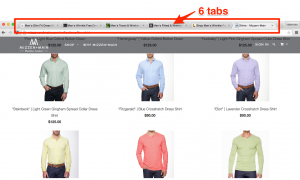
8 User Tests to Help You Learn From Your Competitors

Do you know how your company measures up to the competition?
Business doesn’t happen in a vacuum. And when a user is thinking about buying something on your website, there are two common scenarios. They’re either coming from a competing company’s site, or they’re going to check a few more options before making their final purchase decision.
You know how it works. They have 6 different tabs open in their browser so they can compare all of the options against each other.

So how do you make sure you have the most appealing offering in the eyes of your prospects? How do you make sure your company is their top choice?
Enter: Competitor Testing
A competitor test consists of testing one (or several) of your competitors to figure out what they do well and how you compare. It will help you learn:
- What users like/dislike about your competitors (and your own company)
- How users perceive your brand vs. competing brands (in their own words)
- What the competition does better than you (arming you with ways to improve)
- What the competition does poorly (to avoid making the same mistakes)
- Which company users would prefer to buy from (and why)
- How to improve any part of your company's site (from information architecture and shopping cart workflows, to landing pages and value propositions)
Ultimately, competitor testing will give you user-centered design insights that can help you make your digital property the top choice when your prospects are doing their research.
Whether you want to improve a specific part of your digital asset or get a deeper understanding of best practices, this article will give you eight different tests to get a leg up on your competition.
1. Test a specific part of your site against a competitor
Have users test a specific part of your company’s site. Then, once they’re done, have them test the same part of your competitor’s site. Once they’ve completed both tasks, ask them to compare which experience they preferred and why.
You can run this test on any part of your site, including:
- Pricing pages
- Landing pages
- Shopping carts
- Onboarding processes
- First impression of your homepage
- Any page with a value proposition
Example:
If you’re managing an e-commerce site, ask test participants to go through your website’s checkout process. Then ask them go to your competitor’s site and test their checkout process. Ask them which company they preferred.
Sample UserTesting Session:
2. Test competitors’ sites against each other
This test is almost identical to the previous one. But instead of testing your company against your competitor, you’re going to test Competitor A against Competitor B. This will give you insights into what your users like and dislike about your competition, which they prefer, and why.
Example:
If you’re a SaaS company, ask test participants to create an account and go through the onboarding process for Competitor A’s product. Then ask them to create an account on Competitor B’s site and test their onboarding process. Once they’ve completed both tasks, ask them which company they preferred.
3. Compare your mobile site to a competitor
With Google’s recent “Mobilegeddon” algorithm update, optimizing your mobile site is more important than ever. This test is similar to the previous two tests, the only difference is your participants are using mobile devices.
Example:
Ask test participants to complete a task on your mobile site. Then ask them to go to your competitor’s mobile site and complete the same task. Once they’re done, ask them to compare the two sites.
4. Find out who your competitors actually are
Most companies believe they know who their competitors are. You could probably name a list of companies who do something similar to you. But it’s dangerous to assume that your customers have the same list in mind. In reality, they’re comparing your product or service with a much wider variety of competitors than you think.
To find out who your competition really is, design a test that imitates the typical customer journey. Ask test participants to do research on a specific topic like they normally would. You’ll find competitors you might not have thought about, and learn how real users do research about your industry.
Example:
If you’re in charge of the online experience for a hotel in San Francisco, have your test participants start at Google or Hotels.com (or ask them to start wherever they would normally start their research). Ask them to find a place to stay in San Francisco. Leave your tasks very open-ended.
Sample UserTesting Session
[Note: If you're in a rush, just watch the first 30 seconds of this video. But if you want specific tactics and strategies, we suggest watching the whole thing]
5. Test a concept developed by your competitor
If your competitor comes out with a new product, feature, or app, test their concept before you try to compete. No design is perfect when it gets launched, and their new concept is going to have issues. Have users test it. See what they like and dislike. Find out if they even find it useful.
If you identify ways to improve upon your competitor's concept, integrate those improvements into your own design (and launch an even better version). But if you realize that users don't even find their new concept useful, then you've just saved a ton of money by not developing something people don’t even want.
Example:
If you were a large tech company competing with Apple, test the first version of the Apple Watch before developing your own version of it. Find out what the early adopters find valuable and what frustrates them. You can meet the market needs and design a more delightful experience by implementing those insights into your own design process.
6. Test comparable companies
If you’re only testing your direct competitors, you’re missing out. You can learn a lot from testing companies that are comparable to yours. What do I mean by “comparable”? Well, try testing the site of company that’s doing something similar to you and has a strong online presence.
Example:
If you’re the digital manager for an online food delivery service, try testing an online flower delivery company. Although flower delivery isn’t as time-sensitive, testing their on-site UX will give you a lot of qualitative data to improve your own company’s site.
7. Test non-competitors
If you want to improve a specific part of your company's site (like the checkout process, for example), you don’t even need to test your own competitors. In this case, it doesn’t matter what type of company you test because you can learn UX best practices from outside of your industry.
Example:
If you’re in charge of the online experience for a retail clothing e-commerce site and you like Airbnb’s checkout process, then test it. Find out what users love and implement it into your own design.
8. Test a competitor’s app
If you’re an app developer, the best way to figure out what changes you should implement in your next development cycle is to “spy” on your competition. By testing your competitor’s app, it’s easy to see what people say about it. When you analyze what they say about it, you can find out what they love, and what disappoints them.
Example:
If you’re building a new mobile game app, test similar games early in your development cycle. This will help you learn what people like and dislike about the current apps (which you can either improve upon, or eliminate).
Sample UserTesting Session:
Conclusion
I’d like to leave you with a few optimization tips:
- For a step-by-step competitor test template, click here
- Have test participants go through the same set of tasks for each site
- Start half of your users on Site A and start the other half on Site B
- When you design your test, don’t indicate which site is yours. If participants don’t know which site is yours they’re much more likely to give you honest, candid feedback
Competitor tests show you what users like and dislike about your competition, what your competitors are doing well, and where they can improve. But most importantly, they give you a glimpse into your customer’s mind.
Remember, when people are doing research online, they’re looking for a reason to disqualify your offer. If you want to make sure that your product or service is the most appealing option, you need to see the competitive landscape through your customer’s eyes.





